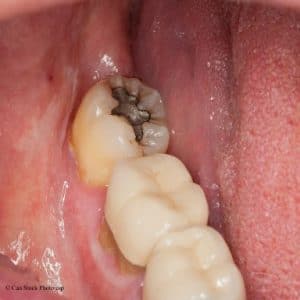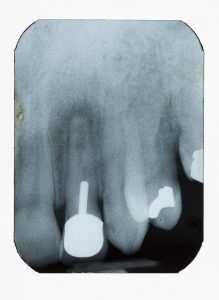 You come in for your routine examination, and the dentist tells you that the filling done back in 1980 needs to be replaced. In the early days of dentistry, it was common to place silver amalgam restorations or fillings. In the past, the doctor had to make a frame for the filling material so that the material would “lock” into the tooth. This process took away a lot of healthy tooth structure. Silver fillings or amalgam fillings last a long time, but when they start pulling away from the tooth, (cracking), breaking off, causing discoloration, or when you experience sensitivity, that filling needs replacing. Today, we directly bond white colored filling material to the tooth.
You come in for your routine examination, and the dentist tells you that the filling done back in 1980 needs to be replaced. In the early days of dentistry, it was common to place silver amalgam restorations or fillings. In the past, the doctor had to make a frame for the filling material so that the material would “lock” into the tooth. This process took away a lot of healthy tooth structure. Silver fillings or amalgam fillings last a long time, but when they start pulling away from the tooth, (cracking), breaking off, causing discoloration, or when you experience sensitivity, that filling needs replacing. Today, we directly bond white colored filling material to the tooth.
How Does Bacteria get under a Silver Filling?
From years of replacing silver fillings with white fillings, I have learned that amalgam fillings leak. I have placed numerous silver fillings, and I know for a fact that I removed all of the decay, but when I take out the filling, I find decay. How did it get there except for bacteria somehow getting into a crevice of the filling?
White Fillings are Superior
That’s why bonding is the future, and silver amalgam fillings are part of a Third World Country. White fillings are superior.
Unfortunately, since the decay under the silver filling has gone undetected for so long, it may have claimed too much tooth structure. If there is not enough of the natural tooth left, you may need an onlay or a crown.
Unlike some believe, even crowns or onlays do not last forever. Once decay has found its way in from the margin of the crown or onlay, there is no other alternative than to replace the restoration.
X-rays Can Help Detect Decay 
Periodic images taken can help detect decay under a filling. We can see dark images that indicate the possibility of an infection. The image can also let us know if the sensitivity you are feeling is something more than a simple fix. If shadows are around the roots of the tooth, it may need a root canal.
Good Oral Hygiene Can Delay Replacement
The best defense from having to replace restorations is the removal of plaque, the sticky substance that causes decay. Floss once a day; brush twice a day, and NEVER eat or drink anything but water after your nightly brushing session.
Careful attention to oral hygiene will help dental work last longer, but, unfortunately, sooner or later, restorations will need replacing.
